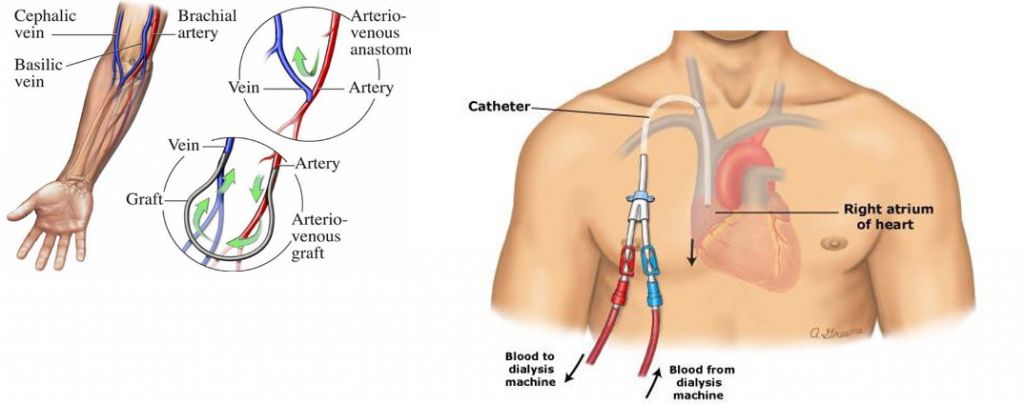Pedes Orange County is a vascular specialty group providing dialysis access treatment and management in an outpatient setting. Our outpatient vascular center specializes in minimally invasive procedures using the latest in state-of-the-art imaging, diagnostic, and interventional services to meet the needs of dialysis patients for their dialysis access care and management.
Our physicians are highly trained with over 50 years of combined dialysis experience providing safe, effective, and individualized care in a comfortable outpatient setting. From the time of initial evaluation and diagnosis to treatment and through recovery, Pedes Orange County is dedicated to delivering exceptional hemodialysis care for every patient to get them back to their daily lives as quickly as possible.
What is Dialysis?
The kidneys are a pair of organs, each about the size of a fist, located on either side of your spine. They are responsible for purifying your blood by removing waste and excess fluid from your body. When the kidneys do not work properly, dialysis is used to perform the function of the kidneys.
Dialysis is a treatment that filters and purifies the blood using a machine. This helps keep your body in balance when the kidneys can’t do their job. Dialysis has been used since the 1940s to treat people with kidney problems.
Types of Dialysis: Hemodialysis vs Peritoneal Dialysis
Hemodialysis
Hemodialysis is the most common type of dialysis. It uses an artificial kidney, known as a hemodialyzer, to remove waste and chemicals from your blood. To get the blood to flow to the artificial kidney, a doctor will surgically create a vascular access, or an entrance point, into the blood vessels. This vascular access will allow a larger amount of blood to flow through the body during hemodialysis treatment. This means more blood can be filtered and purified.
The two type of vascular access designed for long-term dialysis treatments are an arteriovenous (AV) fistula, which connects an artery and a vein and an AV graft, which is a looped tube. For short-term use, a catheter may be inserted into the large vein in the neck.
Hemodialysis treatments usually last three to five hours, will vary by patient. The treatment is typically needed three times per week. However, hemodialysis treatment can also be done in shorter, more frequent sessions.
Most hemodialysis treatments are done at a dialysis center. The length of treatment depends on your body size and the amount of waste in your body.

Peritoneal Dialysis
Peritoneal dialysis involves surgery to implant a catheter into your belly area. During treatment, a special fluid called dialysate flows into your abdomen. Once the dialysate draws waste out of the bloodstream, it’s drained from your abdomen.
There are numerous different types of peritoneal dialysis, but the main ones are continuous ambulatory peritoneal dialysis and continuous cycler-assisted peritoneal dialysis. In continuous ambulatory peritoneal dialysis, your abdomen is filled and drained multiple times each day. Continuous cycler-assisted peritoneal dialysis, however, uses a machine to cycle the fluid in and out of your abdomen. It’s usually done at night while you sleep.
What procedures does Pedes Orange County perform?
Fistulogram
A fistulogram is a special x-ray procedure. It uses contrast (x-ray dye) to look at the blood flow in the fistula or graft (dialysis access). This procedure can check to see if it is blocked or if there is any narrowing (stenosis). Typically when a stenosis is noted, the provider will insert and balloon and inflate it along the narrowing. This breaks up any scar tissue causing the stenosis and allows the blood to flow better for dialysis.
Declott
An AV fistula or graft can develop a clot inside for various reasons (stenosis, low blood pressure, etc) When this clot develops it eventually blocks the entire flow and dialysis can no longer be conducted. At Pedes Orange County, we use different methods to evacuate the clot and re-establish flow from the artery into the fistula or graft, making the access usable for dialysis again.
Catheter Placement/Exchange
HD Catheters are considered to be temporary access points for dialysis. It is the goal for the patient to have long term access like an AV fistula/graft or peritoneal catheter. HD Catheters are direct lines to the blood stream and have a high infection rate, thus them being temporary solutions. Catheters are used for patients who need to start dialysis but do not have a permanent access yet, the access no longer works, or they are letting the access rest. HD Catheters are locked with heparin to avoid any clot developing in the tubes preventing flow. Although locking the catheter with heparin does not always prevent the clot development and catheters have to be exchanged for a new one.
Fistula Creation
PD Catheter Placement
PD Catheter Placement is typically performed as a minimally invasive procedure in an outpatient setting. The specialists at Pedes Orange County perform percutaneous and laparoscopic catheter placement, which is far less invasive than surgery. A PD catheter is placed through the abdomen and into the peritoneal space through the peritoneal membrane, the thin membrane that lines the abdominal wall. Percutaneous catheter placement is performed using fluoroscopy, an image guided technique that uses X-rays to help the vascular specialist view the inside of the abdomen. This procedure can typically be performed in under and hour and requires only local anesthesia and sedation.



